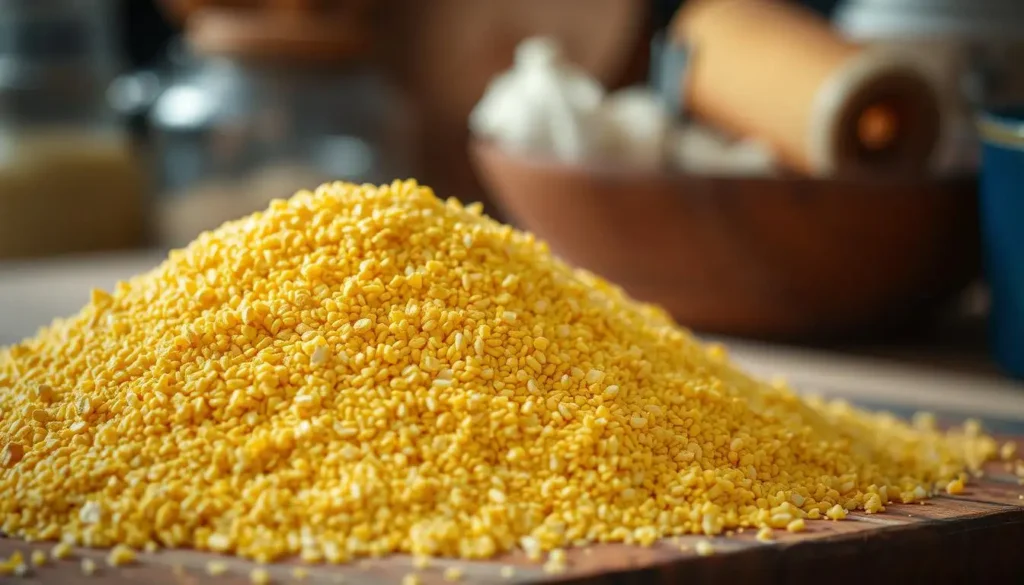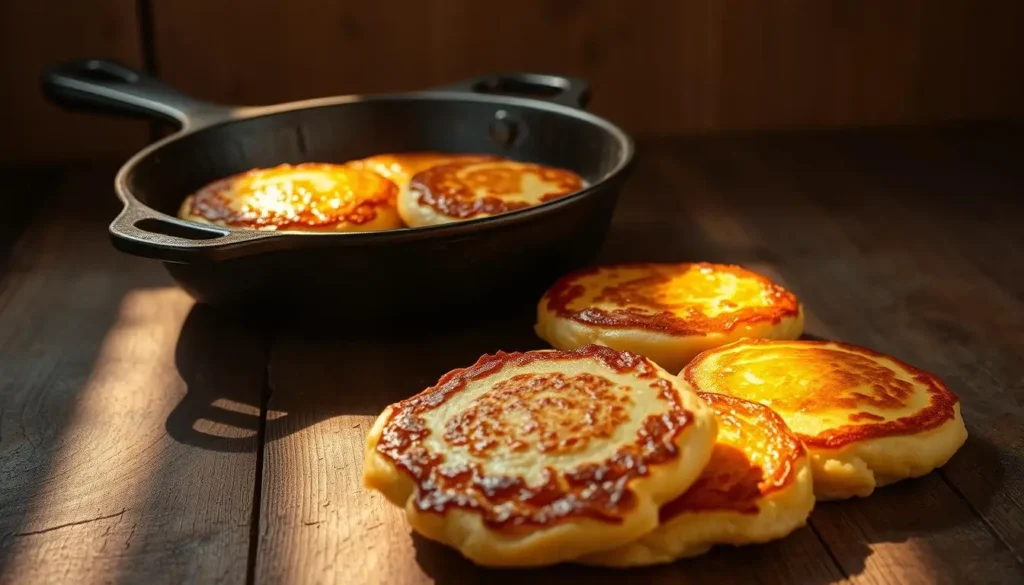Break galettes form suckers, you are in the right place! If you are pining authentic Southern comfort food, this form is for you. Break galettes, also known as cornmeal flapjacks or Johnny galettes, are golden and crisp on the outside, ethereal outside. They are cooked in a hot skillet until impeccably browned.
These rustic galettes were formerly cooked on a hoe over an open fire. Now, they are loved for their rich history and simple medication. You can enjoy them sweet with honey or saccharinity, or savory with fried funk, flora, or BBQ.
In this post, we’ll guide you on making hoe galettes from scrape. We will partake tips for the perfect texture and how to store and overheat them. Whether you are a Southern food sucker or new to it, this companion will help you cook like a pro.
Key Takeaways
Break galettes are a protean Southern dish that can be served at any mess.
They’re made from simple constituents, substantially cornmeal.
Traditional cuisine styles involve a cast- iron skillet.
Break galettes have a rich history in Southern cookery.
They offer a succulent taste of tradition with every bite.
The Rich History of Southern Break galettes
For centuries, Southern hoe galettes have been further than just a mess; they are a connection to the history and a testament to the rich cultural heritage of the South. Roo.ted in simplicity and tradition, these cornmeal flapjacks have evolved, yet remain a chief in Southern cookery.
Origins of the Name” Break galettes”
The origin of the name” hoe galettes” is frequently shrouded in riddle. Contrary to popular belief, these cornmeal flapjacks were n’t cooked on a hoe over an open honey. rather, the name likely stems from the griddle or” break” used for cuisine. literal substantiation suggests that early American culinarians employed whatever cuisine tools were available, including hoes or hoelike griddles.
Cultural Significance in Southern Cuisine
Break galettes hold a special place in Southern cookery, embodying the simplicity and resourcefulness of traditional cuisine. They’re a testament to the artistic heritage of the South, where refections were frequently made from simple, locally sourced constituents.
elaboration Through Generations
Over generations, break galettes have evolved, with colorful regions developing their own twists on the traditional form. Despite these changes, the substance of hoe galettes remains unchanged, connecting families and communities through a participated culinary tradition.
Essential constituents for Traditional Break galettes
The secret to great hoe galettes is in their simple, quality constituents. Traditional Southern hoe galettes use a many crucial constituents that have stayed the same for generations.
The main component is tone- rising cornmeal, which gives structure and flavor. tone- rising flour is added to make the hoe galettes less thick and toothy.

Eggs are also crucial, acting as a binder. They hold the admixture together. Buttermilk adds humidity and a pungent flavor, typical of Southern cuisine.
The choice of fat is important too. Traditional fashions frequently use vegetable oil painting or bacon grease. Bacon grease gives a hoarse flavor, a hallmark of Southern fashions.
- Self-rising cornmeal
- Self-rising flour
- Eggs
- Buttermilk
- Vegetable oil or bacon grease
Using these essential constituents and following traditional fashions will help you make authentic hoe galettes. They will capture the substance of Southern cuisine.
Basic Break galettes form Step- by- Step companion
This companion will help you make traditional Southern hoe galettes like a pro. Making hoe galettes is easy. You just need to prepare the right batter, toast your skillet, and cook them precisely.
Preparing the Batter
The batter is the base of great hoe galettes. You will need 1 mug of fine cornmeal, 1/2 mug of all- purpose flour, 1 tablespoon of swab, 1/4 tablespoon of incinerating soda pop, 1 mug of buttermilk, and 1 large egg. Mix the dry constituents together in a coliseum. This makes the hoe galettes cook unevenly.
In another coliseum, mix the buttermilk and egg until well combined. Add the wet constituents to the dry constituents, stirring until smooth. The batter should be thick but pourable. Add further buttermilk if demanded.
Proper Skillet Temperature
Getting your skillet to the right temperature is crucial for perfect hoe galettes. Preheat a cast iron skillet or anon-stick skillet over medium heat. Test the heat by fluttering water on the skillet.However, it’s ready, If it sizzles and evaporates presto. Add oil painting or bacon drippings for redundant flavor.
cuisine ways
launch by lading the batter with a 1/4 mug measuring mug onto a hot skillet. Leave about 2 elevation of space between each cutlet. This lets them spread duly.
Cook the hoe galettes for 3- 4 twinkles on the first side. Look for bubbles and dry edges. also, flip them and cook for 2- 3 twinkles more, until they are golden and crisp.
Enjoy your hoe galettes hot, perhaps with honey, adulation, or alongside Southern dishes. With practice, you will make them like a pro, perfect for skillet cuisine suckers.
For perfect hoe galettes, keep the skillet at the right temperature. Do not overcrowd it, or your galettes might be slithery or undercooked.
Choosing the Right Cornmeal for Your Break galettes
The right cornmeal is crucial for great hoe galettes. The type you choose affects the texture and taste.
tone- rising cornmeal is easy because it has baking greasepaint formerly. But, it has redundant constituents that can change the flavor and texture.

Many prefer fine ground cornmeal for its smooth texture. It mixes well with other ingredients, making a better batter.
When picking cornmeal, consider these factors
The type of cornmeal tone- rising or regular
The grind size forfeiture, medium, or coarse
The brand and quality of the cornmeal
Choosing the right cornmeal can make your hoe galettes amazing. Try different types and grinds to find your fave.
The Perfect Skillet Cast Iron vs Other Cookware
Cast iron skillets are best for cooking hoe galettes. They keep heat well and cook unevenly. This ensures your hoe galettes are perfect.killets are best for cooking hoe cakes. They keep heat well and cook evenly. This ensures your hoe cakes are perfect.

A cast iron skillet is a great addition to any kitchen. It’s perfect for cooking hoe galettes. Make sure to duly season it for anon-stick face and easy cleaning.
Seasoning Your Cast Iron
To season your cast iron skillet, clean it well first. also, apply a thin subcaste of cooking oil painting to every area. toast the skillet in the roaster at 350 °F( 175 °C) for an hour to let the oil painting polymerize.
Let it cool before wiping off any redundant oil painting with a paper kerchief. Repeat this process several times to make up a robust seasoning subcaste.
Temperature Control Tips
Controlling the temperature is crucial when cooking hoe galettes in a cast iron skillet. Preheat the skillet over medium heat. Use a thermometer to insure it reaches the ideal temperature of around 375 °F( 190 °C).
You can test the temperature by fluttering a many drops of water onto the skillet.However, it’s ready to cook, If they sizzle and dematerialize snappily.
By using a cast iron skillet and following these tips, you will get impeccably cooked hoe galettes every time. The key is to be patient and attentive to the cuisine process, conforming the heat as demanded.
Common miscalculations to Avoid When Making Break galettes
The art of making hoe galettes is n’t just about following a form. It’s also about avoiding common crimes. Break galettes, a cherished Southern chief, bear a certain finesse to get right. One of the most critical aspects is preparing the batter rightly.
Overmixing is a common mistake that can make hoe galettes thick rather of light and ethereal. It’s essential to mix the wet and dry constituents independently and gently fold them together until just combined. This fashion helps save the delicate structure of the constituents.
Another critical factor is achieving the right skillet temperature.However, it can affect the cuisine process significantly, If the skillet is too hot or not hot enough. A cast- iron skillet, when duly seasoned and heated, can give a harmonious cuisine face. It’s vital to test the temperature by fluttering a many drops of water onto the skillet; if they sizzle and dematerialize snappily, it’s ready for cuisine.
cuisine ways also play a significant part in the outgrowth of your hoe galettes. icing that the batter is spread unevenly and cooked for the right quantum of time is critical. cuisine tips include not overcrowding the skillet and conforming the heat as necessary to help burning.
Use the right type of cornmeal for the stylish flavor and texture.
Do not overmix the batter to keep the hoe galettes light.
insure your skillet is at the right temperature before cuisine.
By avoiding these common mistakes and following the right cooking techniques, you can enjoy perfectly cooked Break galettes every time. Whether you are a seasoned chef or just starting out, understanding these risks can elevate your hoe cutlet game and impress your family and musketeers.
Regional Variations of Traditional Break galettes
Regional pride and original constituents have converted hoe galettes into a variety of distinct styles across the South. While the core conception remains the same, different regions have put their own twist on this traditional dish. This creates a rich diversity that reflects the complexity of Southern cookery.
Georgia- Style Break galettes
In Georgia, hoe galettes are frequently made with a hint of agreeableness. They incorporate original cornmeal and occasionally a bit of sugar or honey into the batter. This agreeableness dyads impeccably with traditional Southern incidents like biscuits and jam.
Mississippi Delta Version
The Mississippi Delta region is known for its rich agrarian land. This influences the hoe galettes made there. Hearty and thick, these break galettes are frequently cooked by well- seasoned cast- iron skillets. This creates a crispy outer layer that perfectly contrasts with the soft, tender interior
Coastal Carolina Acclimations
In Coastal Carolina, hoe galettes frequently include fresh seafood. They are a great match for seafood dishes. This blend of hoe galettes and seafood creates a succulent emulsion that is uniquely Carolina.
Break galettes in this region show how protean they are. They punctuate the different culinary geography of the South. Each interpretation brings a unique taste, blending traditional fashions with southern variations.
Serving Suggestions and Condiments
Break galettes are simple, making them perfect for numerous condiments and uses. They fit any mess, from breakfast to regale.
For a Southern touch, try them with adulation and saccharinity. Maple or club saccharinity works well. Add sour cream or chives for redundant flavor.
Brace hoe galettes with Southern pets like fried funk or regale.
Top with fresh sauces like parsley or chives for a fresh twist.
Try them with a fried egg for a hearty breakfast.
Food suckers say break galettes are a Southern chief. They are great for any mess. You can indeed use them as a base for breakfast skillets or as brickle croutons in salads.
Try different condiments and ways to serve them. You might find a new favorite way to enjoy hoe galettes, a true Southern cookery classic.
Making Ahead and Storage Tips
With a many tips, you can enjoy hoe galettes at their stylish, indeed if you make them ahead. This is great for busy mornings or big refections.
Knowing how to store and overheat hoe galettes is crucial. Proper storehouse keeps them fresh and preserves their texture and flavor.
Proper storehouse styles
There are several ways to store hoe galettes, depending on how soon you will eat them.
Room Temperature Store cooled hoe galettes in an watertight vessel at room temperature for over to 2 days.
Refrigeration For longer storehouse, place the cooled hoe galettes in an watertight vessel and chill for over to 5 days.
indurating Freeze the cooled hoe galettes on a baking distance, also transfer them to a freezer-safe bag or vessel for over to 3 months.
Reheating ways
Reheating hoe galettes is easy, and the system affects their texture and taste.
To achieve a crisp surface, reheat hoe cakes in a toaster oven or convection roaster until they’re heated through
Microwave oven For a quick reheat, microwave oven the hoe galettes for 20- 30 seconds, or until they are hotted through. Be conservative, as overheating can make them dry.
Reheat hoe cakes in a skillet over medium heat with a small amount of oil or butter to prevent sticking and enhance their flavor.
learning these storehouse and reheating ways lets you enjoy hoe galettes anytime. They are a protean and accessible mess option.
ultramodern Twists on Classic Break galettes
The classic hoe cutlet form has seen numerous changes. These updates meet moment’s tastes and salutary requirements. Now, there are new performances that keep the traditional taste but also excite ultramodern palates.
One big change is adding gluten-free constituents. This makes hoe galettes available to further people. Gluten-free cornmeal and other flours are now common in fashions. They let everyone enjoy this Southern fave.
Gluten-Free Acclimations
Gluten-free hoe galettes are getting more popular. They use gluten-free cornmeal and other constituents to taste just as good as the original. Some variations include almond flour or coconut flour to enhance the texture and add extra flavor.
When making gluten-free hoe galettes, it’s crucial to get the cornmeal to flour rate right. Also, choose the right liquid constituents. Buttermilk or other milks help keep the galettes wettish and tender.
Contemporary Flavor Combinations
Break galettes have evolved with new flavors. constituents like jalapenos, cheddar rubbish, and sauces like chives or scallions give them a ultramodern twist.
fashions now include transnational flavors, similar as Korean chili flakes or Mexican spices. These add a unique kick to the classic form.
Whether you stick to traditional flavors or try new bones , break galettes are protean. They offer a oil for culinary creativity.
Troubleshooting Your Break galettes form
Perfecting hoe galettes is n’t just about following a form. It’s also about working common problems.
One common issue is a batter that is too thick or too thin.However, add further liquid to make it right, If it’s too thick.
Another problem is uneven cuisine. This can be if your skillet is not hot enough or if you cook the galettes for too short a time. Make sure your skillet is hot and cook the galettes until they are golden.
Using the wrong type of cornmeal can affect the taste and texture of your hoe galettes.
Not preheating the skillet duly can lead to uneven cuisine.
Flipping the hoe galettes too soon or too late can affect in them not cooking rightly.
To break these common issues, be patient and vigilant while cooking. Troubleshooting these problems will help you perfect your hoe galettes form.
Knowing how to fix these issues ensures your hoe galettes will be perfect every time.
Conclusion learning the Art of Southern Break galettes
learning hoe galettes is further than just following a form. It’s about connecting with Southern cookery’s rich heritage. The history and artistic significance of hoe galettes make them a crucial part of Southern cuisine.
By following the way in this composition, you will learn to make succulent, authentic hoe galettes. Trying out traditional fashions lets you add your own twist, making it a true reflection of your creativity.
The art of making hoe galettes is a skill passed down through generations. It brings people together through the participated love of Southern cookery. As you master hoe galettes, you recognize traditions and produce new recollections at the table.
FAQ
What’s the traditional component used to make hoe galettes?
The traditional component used to make hoe galettes is fine- ground cornmeal.
Can I make hoe galettes without buttermilk?
Yes, you can make hoe galettes without buttermilk. Use a blend of milk and ginger or bomb juice rather.
What type of skillet is stylish for cuisine hoe galettes?
A cast- iron skillet is the stylish for cuisine hoe galettes. It retains and distributes heat well.
How do I achieve the perfect crisp surface and ethereal innards for my hoe galettes?
To get the perfect crisp surface and ethereal innards, make sure your skillet is hot. Cook the hoe galettes for the right quantum of time.
What’s the difference between tone- rising and regular cornmeal, and which one should I use for hoe galettes?
tone- rising cornmeal has baking greasepaint and swab mixed in. Regular cornmeal does not. For traditional hoe galettes, you can pick moreover. But if you choose regular cornmeal, you will need to add baking greasepaint and swab yourself.
Can I make hoe galettes ahead of time, and if so, how do I store them?
Yes, you can make hoe galettes ahead of time. Cool them down first. also, put them in an watertight vessel and keep them in the fridge or freezer.
How do I overheat leftover hoe galettes?
To overheat leftover hoe galettes, wrap them in antipode. also, warm them in the roaster. Alternatively, you can warm them up in a toaster oven or a countertop roaster.
Can I make gluten-free hoe galettes?
Yes, you can make gluten-free hoe galettes. Just use gluten-free cornmeal. Make sure all other constituents are gluten-free too.
What are some common miscalculations to avoid when making hoe galettes?
Do not use the wrong cornmeal or the wrong skillet temperature. Also, avoid overmixing the batter.
How can I troubleshoot issues with my hoe galettes form?
To fix problems, check your constituents and cuisine system. Also, make sure your skillet temperature is right. Acclimate as demanded to get the stylish result.
Hoe Cakes Recipe
Equipment
- 1 Mixing Bowl For combining ingredients
- 1 Whisk To blend wet and dry ingredients
- 1 Skillet Preferably cast iron
- 1 Spatula For flipping the hoe cakes
Ingredients
- 1 cup cornmeal yellow fine or medium grind
- 1/2 cup all-purpose flour
- 1 tsp baking powder
- 1/2 tsp salt
- 1 tbsp sugar optional for mild sweetness
- 1 egg lightly beaten
- 1 cup buttermilk or milk with 1 tsp vinegar
- 2 tbsp melted butter plus more for frying
- oil or butter for frying
Instructions
- In a bowl, mix together cornmeal, flour, baking powder, salt, and sugar.
- In another bowl, whisk the egg, buttermilk, and melted butter.
- Pour the wet ingredients into the dry ingredients and stir until just combined.
- Heat a skillet over medium heat and lightly coat it with oil or butter.
- Spoon 2–3 tablespoons of batter for each hoe cake onto the skillet.
- Cook for 2–3 minutes on each side until golden brown and crisp.
- Serve hot with butter, honey, syrup, or as a side to savory dishes.
Notes
- For crispier edges, use a well-seasoned cast iron skillet.
- Add corn kernels or jalapeños for texture and heat.
- Leftovers can be refrigerated and reheated in a toaster oven.


